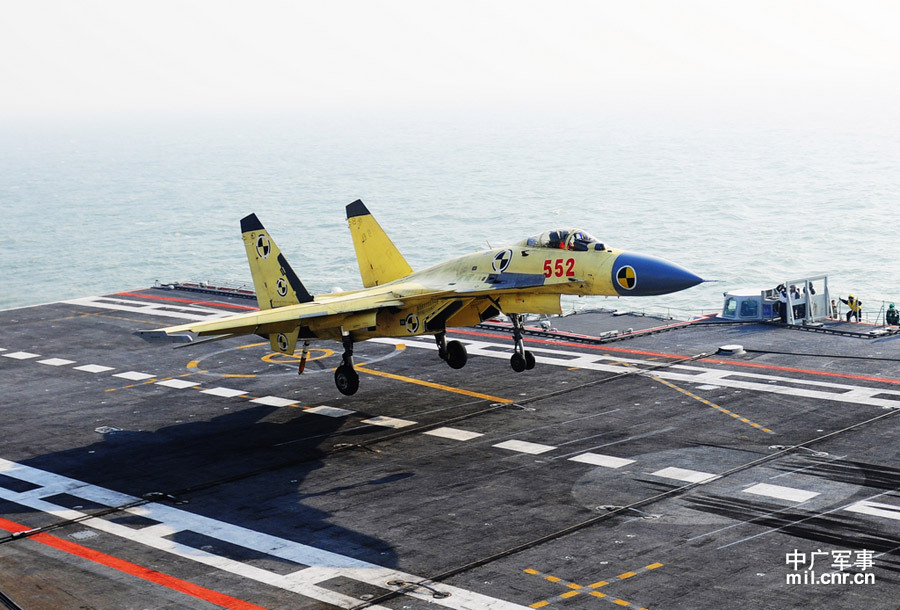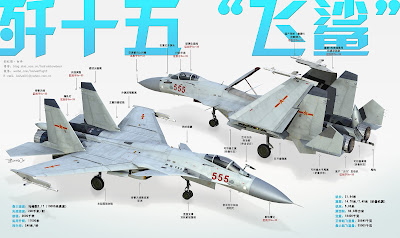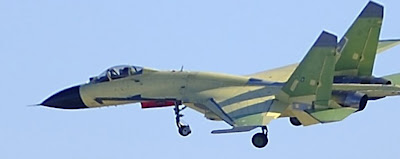From Wikipedia, the free encyclopedia
| J-15 | |
|---|---|
| Role | Carrier-based Multirole fighter |
| National origin | People's Republic of China |
| Manufacturer | Shenyang Aircraft Corporation |
| Designer | Sun Cong |
| First flight | August 31, 2009[1] |
| Introduction | 2012 |
| Status | In production, in active service |
| Primary user | People's Liberation Army Naval Air Force |
| Number built | ~ 16 |
| Developed from | Shenyang J-11B |
Contents
Design and development
Russian military experts have downplayed any significant competition from the J-15 in the global arms market, with Col. Igor Korotchenko of the Defense Ministry stating in early June 2010, "The Chinese J-15 clone is unlikely to achieve the same performance characteristics of the Russian Su-33 carrier-based fighter, and I do not rule out the possibility that China could return to negotiations with Russia on the purchase of a substantial batch of Su-33s."[1] China has actively sought to purchase Su-33s from Russia on numerous occasions—an unsuccessful offer was made as late as March 2009[6]—but negotiations collapsed in 2006 after it was discovered that China had developed a modified version[7][8][9] of the Sukhoi Su-27SK designated the Shenyang J-11B,[10][11][12] in violation of intellectual property agreements.[1]The first J-15 prototype is believed to have performed its maiden flight on August 31, 2009, powered by Russian-supplied AL-31 turbofan engines.[5] Video and still images of the flight were released in July 2010, showing the same basic airframe design as the Su-33.[13] In July 2011, it was reported FWS-10H turbofan engine was chosen for J-15 fighter, which has takeoff thrust increased to 12,800 kg, comparing FWS-10 turbofan's 12,500 kg. Other improvements were also made to make it better suited to carrier-based fighter's requirement.[14] On May 6, 2010, the aircraft conducted its first takeoff from a simulated ski-jump.[5]
The reliance on ski-jump launches and the lack of Chinese carrier based refueling capabilities are believed to greatly reduce the effective range of the J-15.[15]
The J-15 is reported to use different avionics and systems than the Su-33, and uses Chinese-developed technologies, and features various upgrades such as AESA radar, composite and radar absorbent material, MAWS, improved IRST, and new electronics.[16] An article in the China Signpost believes the J-15 "likely exceeds or matches the aerodynamic capabilities of virtually all fighter aircraft currently operated by regional militaries, with the exception of the U.S. F-22 Raptor",[17] alleging that the J-15 likely possesses a 10% superior thrust-to-weight ratio and a 25% lower wing loading than the F/A-18E/F Super Hornet[17][better source needed] However, one of the authors of that same article described the J-15 in another as no game changer[18]; Hu Siyuan of the National Defense University PLA China has said that "the current weak point of the J-15 is its Russia-made Al-31 engines which are less powerful than that of the American F-35 fighter".[19]
A twin seat variant made its maiden flight on November 4, 2012. The general designer of J-15 is Mr. Sun Cong (孙聪).[20]
The J-15's chief designer, Sun Cong of the National Committee of the Chinese People's Political Consultative Conference, has said that the J-15 could match the F/A-18 in bomb load, combat radius and mobility. However, in a similar statement, more work was required in its electronics and combat systems.[21] He also indicated the lack of mature domestically produced engines as a current weak spot.[22]
Rear Admiral Yin Zhuo stated that the aircraft's air combat capabilities were better than that of the F/A-18E/F Super Hornet. However, he also stated that its ability to attack land and sea targets were slightly inferior to the F/A-18E/F. It is also stated that its electronic equipment meets the standards of those on a fifth generation fighter.[23]
Beijing-based Sina Military Network has argued the combination of ski-jump operations along with the base airframe of the overweight and underpowered Su-33 leaves the J-15 with the choice between carrying maximum fuel and minimal weapons or a modest weapons load and hardly any range.[24]
Operational history
On 25 November 2012, Chinese media announced that two J-15s had made successful arrested landings on the aircraft carrier Liaoning.[25][26][27] The first pilot to land on the Liaoning was named as Dai Mingmeng (戴明盟).[28] PLA Daily newspaper indicated first five naval pilots including Dai conducted J-15 fighter landing and taking off. Test and training program officials confirmed the carrier-borne aircraft and special equipment for the landing flight had gone through strict tests, and fighter jets can be deployed on the carrier.[29]In December 2013 Chinese media reported that mass production of J-15s in full operational condition with combat markings had begun.[30]
Specifications
General characteristics- Crew: 1-2
- Length: 21.9 m (72 ft)
- Wingspan: 14.7 m (48.25 ft)
- Height: 5.9 m (19.5 ft)
- Wing area: 62.04 m2 (667.80 ft2)
- Empty weight: 17500 kg (38600 lb)
- Loaded weight: 27000 kg (60000 lb)
- Max. takeoff weight: 33000 kg (72752 lb)
- Powerplant: 2 × WS-10A[31] afterburning turbofans[31]
- Dry thrust: 89.17 kN (20,050 lbf) each
- Thrust with afterburner: 135 kN[31] (33,000 lbf[31]) each
- Wingspan, wings folded: 7.4 m (24.25 ft)
- Maximum speed: Mach 2.4[31]
- Range: 3500 km[32] (2050 mi)
- Service ceiling: 20000 m[31] (65700 ft)
- Rate of climb: 325 m/s[31] (64000 ft/min)
- 1 × 30 mm GSh-30-1 cannon with 150 rounds
- Munitions on twelve external hardpoints, including:
- 8 × PL-12 or R-77, and 4 × PL-9 or R-73 air-to-air missiles
- Various bombs and rockets
- Anti ship and anti radiation missiles.
- Electronic countermeasure (ECM) pods
See also
- Related development





No comments:
Post a Comment